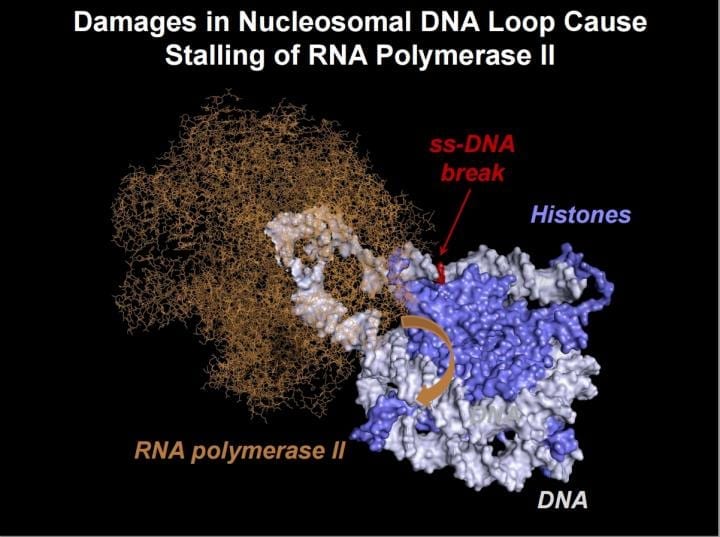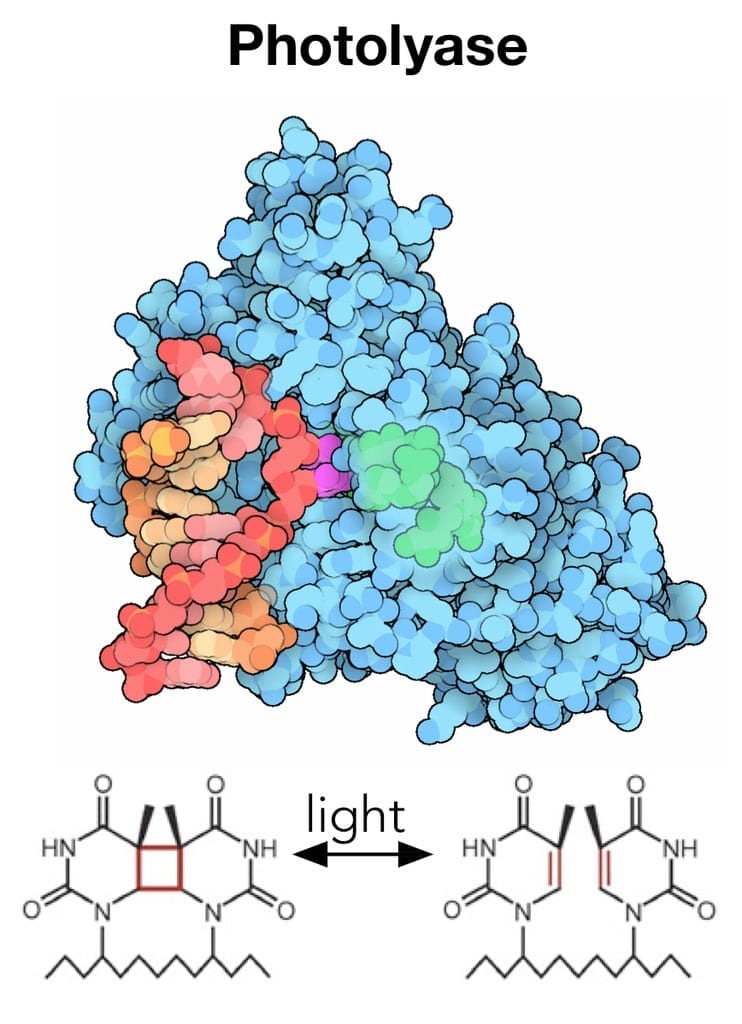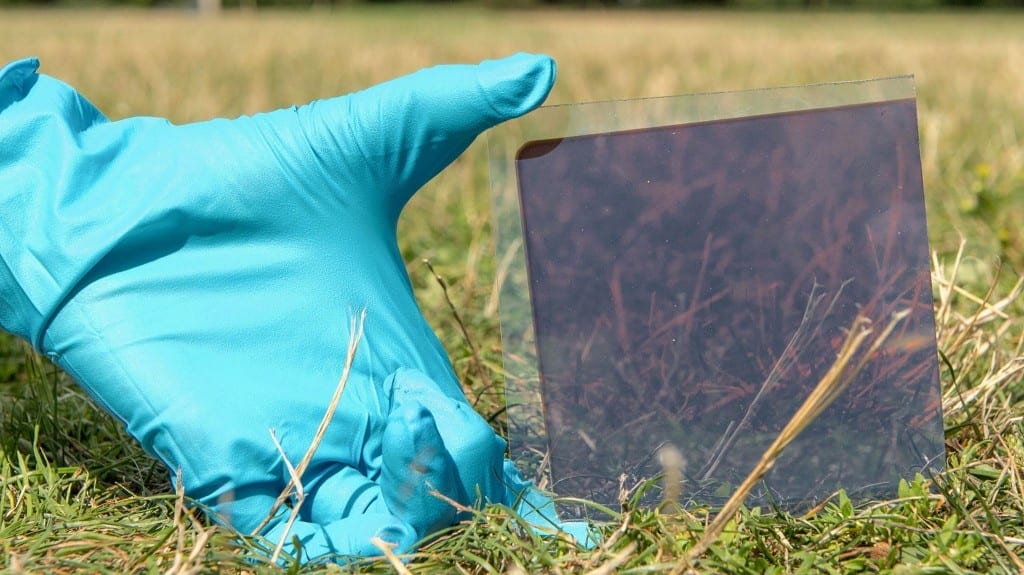
CREDIT
Nadezhda S. Gerasimova et al
Researchers from the Lomonosov Moscow State University discovered a new mechanism of DNA repair, which will help to treat and to prevent diseases in the future
The DNA molecule is chemically unstable giving rise to DNA lesions of different nature. That is why DNA damage detection, signaling and repair, collectively known as the DNA damage response, are needed.
A group of researchers, lead by Vasily M. Studitsky, professor at the Lomonosov Moscow State University, discovered a new mechanism of DNA repair, which opens up new perspectives for the treatment and prevention of neurodegenerative diseases. The article describing their discovery is published in AAAS’ first open access online-only journal Science Advances.
“In higher organisms DNA is bound with proteins in complexes called the nucleosome. Every ~200 base pairs are organized in nucleosomes, consisting of eight histone proteins, which, like the thread on the bobbin, wound double helix of DNA, which is coiled into two supercoiled loops. Part of the surface of the DNA helix is hidden, because it interacts with histones. Our entire genome is packed this way, except for the areas, from which the information is being currently read”, — says Vasily M. Studitsky , who is the leading researcher and the head of the Laboratory of Regulation of Transcription and Replication at the Biological Faculty of the Lomonosov Moscow State University.
The dense packing allows DNA molecule with a length of about two meters to fit into a microscopic cell nucleus, but it makes significant surfaces of the DNA inaccessible for the repair enzymes — the proteins that manage the “repair” of damaged DNA regions. The damage of the DNA, if not repaired, leads to accumulation of mutations, cell death, and to the development of various diseases, including neurodegenerative, e.g. Alzheimer’s disease.
A group of researchers, lead by Vasily M. Studitsky, studied the mechanism of detection of single-stranded DNA breaks at which the connection is lost between nucleotides on one strand in the places where the DNA is associated with histones.
Scientists know quite a lot about the mechanism of the repair. It is known that for the synthesis of a protein, information written in the genetic code, which could be imagined as the manual for its assembly where triples of nucleotides match certain amino acids, should be taken out of the nucleus into the cytoplasm of the cell.
Thin and long strand of the DNA is packed in the nucleus and can tear at the exit to the outside. Moreover, it cannot be sacrificed as the cell’s nuclear DNA is is only present in two copies. Therefore, when it is necessary to synthesize specific protein, small region of DNA is unwound, the two strands are disconnected, and the information on the protein structure with one of the DNA strands is written in form of RNA, single-stranded molecule. The mRNA molecule, which serves as the template for making a protein, is synthesized by the principle of complementarity: each nucleotide pair corresponds to another one.
During the transcription of information (its rewriting into RNA) the RNA polymerase enzyme “rides” on the DNA chain, and stops when it finds the break. Like a proofreader of a text, RNA polymerase after it is stalled, triggers a cascade of reactions, resulting in the repair enzymes fixing the damaged area. At the same time, the RNA polymerase cannot detect discontinuities present in the other DNA strand.
Read more: Novel DNA repair mechanism brings new horizons
The Latest on: DNA repair mechanism
[google_news title=”” keyword=”DNA repair mechanism” num_posts=”10″ blurb_length=”0″ show_thumb=”left”]
via Google News
The Latest on: DNA repair mechanism
- Researchers uncover DNA repair mechanism that could yield treatments for cancer, premature agingon May 8, 2024 at 10:47 am
Researchers at the University of Toronto and partner hospitals have discovered a DNA repair mechanism that advances understanding of how human cells stay healthy – a finding that could lead to new ...
- Crick teams up with Broken String to research insidious neurodegenerative diseaseon May 8, 2024 at 8:34 am
Cambridge genomics company Broken String Biosciences has teamed up with the Francis Crick Institute for a key project targeting a progressive and debilitating neurodegenerative disease.
- Enzyme implicated in telomere repair offers new avenues for cancer therapyon May 8, 2024 at 7:05 am
A new study led by University of Pittsburgh and UPMC Hillman Cancer Center researchers shows that an enzyme called PARP1 is involved in repair of telomeres, the lengths of DNA that protect the tips of ...
- Researchers study the intricacies of homologous recombination and abnormal chromosome bridgeson May 7, 2024 at 2:07 pm
The damaged DNA is first resected or cut to create single-stranded ends near the damaged site. These ends are then matched to their corresponding region in an available replicated chromosome, also ...
- Telomere Stability Study Finds New Wrinkle in DNA Repair, Could Inform Anticancer Researchon May 7, 2024 at 1:49 pm
Discoveries about PARP1 biology generate questions that could aid in development of new PARP1-targeting strategies.
- Researchers in Japan confirm DNA damage from acetaldehyde found in body after drinkingon April 26, 2024 at 10:01 pm
A team of researchers from the Tokyo Metropolitan Institute of Medical Science has confirmed damage to human cell DNA caused by acetaldehyde, ...
- A Novel Cellular Mechanism Used to Repair DNA Damage is Revealedon April 25, 2024 at 7:05 pm
The human genome is contained within the nucleus of cells. The genome is well protected, but many things can cause DNA damage, including aging, some drugs.. | Cell And Molecular Biology ...
- Researchers uncover human DNA repair by nuclear metamorphosison April 17, 2024 at 8:23 am
More information: DNA double-strand break–capturing nuclear envelope tubules drive DNA repair, Nature Structural & Molecular Biology (2024). DOI: 10.1038/s41594-024-01286-7 Provided by ...
- Researchers uncover human DNA repair by nuclear metamorphosison April 16, 2024 at 5:01 pm
Researchers have discovered a DNA repair mechanism that advances understanding of how human cells stay healthy, and which could lead to new treatments for cancer and premature aging. Researchers ...
- Discovery of DNA repair mechanism advances understanding of how human cells stay healthyon April 16, 2024 at 5:01 pm
Researchers at the University of Toronto have discovered a DNA repair mechanism that advances understanding of how human cells stay healthy, and which could lead to new treatments for cancer and ...
via Bing News










